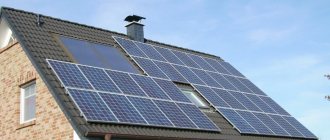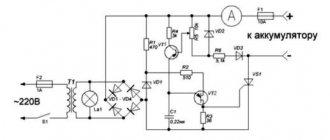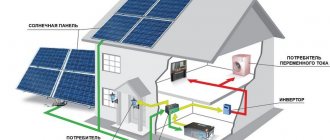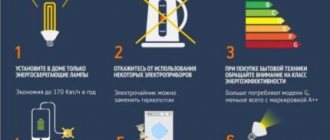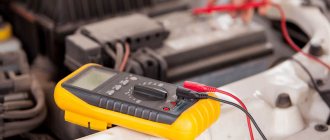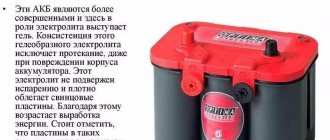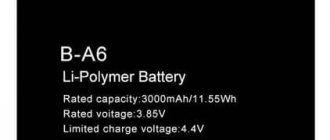Alternative energy systems are increasingly used to supply residential buildings with electricity. Since the modes of generation and consumption of electricity differ, it is necessary to ensure its accumulation for subsequent output. Do you agree?
In order to use energy for the period of time required by the owner, batteries for solar panels are included in the scheme. We will tell you how to correctly select devices designed to operate in charging and discharging cycles. Our recommendations will help you choose the optimal model.
Why are batteries needed in solar power systems?
Since solar radiation is not a constant value and, if you are not connected to the central power grid or the connection is not stable, it is not enough to just have solar panels. You need somewhere to store energy and having reliable batteries will help you store the electricity your solar panels produce throughout the day.
The question of “which battery to choose for solar panels” must be approached extremely seriously in order to use your system in working condition at any time of the day. With the wrong battery bank, you will only be able to take advantage of solar energy when the solar panels are producing it, and when the sun goes down, the batteries may not be able to produce the required power. Without good batteries, you'll have to contend with running out of power, especially if the power grid is intermittent or non-existent.
To put it simply, solar batteries can be called intermediaries. They transfer the resulting electrical power to the end consumer.
Everything ingenious is simple: the solar battery produces maximum electrical energy during intense light irradiation, i.e. during the day. However, most often it is used in the evening, when household appliances are running.
To make it possible to use solar energy when the sun no longer shines, people came up with batteries for solar panels. With their help, excess energy that was generated during the day is preserved in order to be able to use it at night.
Any electric battery provides a reusable constant current with the ability to perform reversible chemical processes. This occurs during multiple charge cycles, when an electric current is passed in the direction opposite to the reverse movement of elementary particles during discharge.
Operating Parameters
Before purchasing a battery for solar panels, you need to familiarize yourself with all the operational nuances. This is due to the fact that only a properly selected battery can ensure reliable operation of the entire system. The main indicators are:
- Energy density level.
- Battery capacity.
- Type.
- Temperature regime.
- Self-discharge ability.
Experts determine the battery capacity by the amount of charge, which is measured during the process of discharging energy to end consumers.
The International System of Units is widely used for technical measurements. But in the CIS countries there has long been a tradition of determining the battery capacity in amperes per hour. To compare the existing design features of different units as accurately as possible, energy density is used. In this case, the total amount of energy that is distributed per unit volume of the battery must be taken into account. Recommended: Selecting a Packard Bell Laptop Battery Regarding self-discharge, this feature is used to provide an accurate analysis of charge loss when the system is idling. This term was first introduced by specialists to assess the quality of operation of a particular installation when it was necessary to achieve long-term energy storage. You should always remember that if the battery is stored in a room where the air temperature exceeds +40 ˚C, then after a few months there will be a loss of capacity by 40-50%.
Types of batteries for solar panels
At the moment, rechargeable batteries (batteries) of various designs, principles of operation and operating conditions have been developed and produced, so it is always possible to choose the model of interest according to the requirements placed on it. Let's consider the existing types of batteries used in solar power plants.
Why not automobiles?
An obvious solution, at first glance, is to install several car batteries from a truck – 180-250Ah – onto a solar power plant.
The assembly power of such batteries should really be enough to power a home, and the cost of one such battery starts from $65 (for a Tyumen battery), however, car batteries are designed for use in completely different conditions and a discharge of even 30% is extreme conditions for them. At the same time, they can produce high starting currents (to start a car engine), which are unlikely to be useful in a residential building.
- Popular solar power plants for home: main parameters
Car battery
The mode of use in a car differs from the use of batteries in a solar power plant system. During daylight hours, the controller basically only charges the battery, and during dark hours, the battery “feeds” all the current collectors. In this mode, the car battery can last no more than a year, after which the capacity will drop very quickly, increasing the risk of boiling and sudden failure.
AGM and GEL batteries
Gel battery
The essence of the operation of this type of battery is similar to that of car batteries, the only difference being that the electrolyte substance is in a bound state. In AGM devices, the electrolyte is placed in glass fiber, it is impregnated with an electrolyte composition. In GEL devices, the electrolyte (sulfuric acid) is placed in a gel form.
Rechargeable batteries of the presented type are widely used in power plant systems powered by solar energy, since their operating mode is associated with a small discharge current and over a long period of time; this mode is not critical for devices of this type.
Also, batteries of this type are not afraid of deep discharge and can withstand repeated charge-discharge modes. The only disadvantage when using such batteries is their sensitivity to charging conditions; overcharging can cause irreparable consequences in the operation of the battery.
The cost of AGM and GEL batteries is higher than that of car batteries.
Batteries OPzS
Battery OPzS
Batteries of this type work on the same principle as those given above (lead-acid), with the only difference that the anode (positive pole) is made tubular and it is this feature of the battery that allows you to increase the number of charge-discharge cycles without disrupting the operation battery OPzS batteries do not require special maintenance; they can be used successfully for a long time. The only unpleasant point is the relatively high price.
Alkaline batteries
A positive quality of this type of battery is its ability to withstand deep discharge with currents of different magnitudes.
Negative qualities include large size and the presence of a memory effect, which is due to the fact that in the event of an incomplete discharge during subsequent charging, the battery loses part of its capacity.
Alkaline battery
In the case of using such batteries in solar power plant systems, situations will periodically arise when the battery discharge is incomplete, as a result of which the batteries will lose part of their capacity, which will ultimately adversely affect the operation of the system as a whole.
- Thermal solar power plants
Lithium batteries
Lithium battery
The positive properties of lithium batteries include high energy intensity, small dimensions, the ability to withstand deep discharge and the ability to quickly charge.
Features of used batteries
Many people believe that there is nothing wrong with buying a used battery instead of a new one. But even here it is necessary to take into account a number of nuances, at a minimum, so that the element meets the requirements for working with solar panels. From the used segment, alkaline traction batteries are recommended as the most durable and high-quality ones.
There is one rule - a lead battery removed from a car a year ago, which has not been charged since then, is definitely not worth taking. If you choose a car battery, it is better to choose a “fresh” one, just removed.
When purchasing, they look at the terminals: if they have a crystal-like coating of white or red color, it is better to refuse such a battery. Such a defect is a sign that the device will soon fail.
Before connecting the battery to the panel, it is charged with a weak current (50% weaker than the manufacturer recommends).
When selecting a battery, they take into account both its parameters and the entire alternative energy system in which it will operate. Saving on batteries is not encouraged; it is better to invest once and be sure that the system will last for several years without problems.
Comparison of different types of batteries
Lead-acid batteries cost less, but they have a shorter lifespan and low energy density by modern standards, and some require regular maintenance to keep them in working order. Lithium batteries are more expensive, but they require little maintenance and have a longer lifespan to match their higher price. Let's take a closer look at which solar power battery is best, the pros and cons of each option, and explain why you might choose one for your system.
Lead-acid with liquid electrolyte
Lead-acid battery with liquid electrolyte
A distinctive feature of these batteries is that the lead plates are immersed in liquid electrolyte. They need to be checked regularly and topped up every 1-3 months to keep them working properly. Negligence in maintenance may shorten their service life and void the warranty. Since this type of battery can emit hazardous gases during operation, they must be installed in a ventilated area to allow battery gases to escape.
Sealed lead acid
Sealed Lead Acid Battery
There are two types of sealed ones: AGM and GEL, which have many similar properties. They require virtually no maintenance and are waterproof. The differences lie in the electrolyte - in a gel battery it is in a thickened state, and in an AGM the electrolyte is absorbed in fiberglass. It is believed that they do not emit gases, this is not entirely true, since to protect the batteries there are valves that can open in emergency situations.
Armored OPzS and OPzV
Armored batteries types OPzS and OPzV
These batteries are a type of lead-acid battery: OPzS - with liquid electrolyte, and OPzV with gel electrolyte. Disadvantages: low energy density and nonlinear discharge characteristics characteristic of all lead-acid batteries. Among the advantages, one can note 1200-1500 cycles, with a discharge depth of 80%, which is 2-3 times more compared to conventional lead-acid batteries, but also a higher price, which is comparable to the cost of LiFePo4 batteries.
Lithium iron phosphate batteries
Lithium iron phosphate batteries
One of the best chemical compositions of lithium batteries for solar cells is lithium iron phosphate LiFePO4, also known as LFP, also called “Lifer”. This technology has a service life several times longer than lead-acid batteries and can be used for deeper cycles. Thanks to linear discharge characteristics, it is possible to use a smaller capacity when discharging with high currents. They also require no maintenance or ventilation, unlike flooded lead-acid batteries. LiFePO4 is one of the types of lithium-ion batteries, but unlike them, LiFePO4 is fire and explosion-proof.
Lithium titanate, also known as LTO
Lithium titanate battery
We can confidently say that these are excellent batteries and one of the best at the moment and they have all the above advantages of LiFePO4 batteries, but they can also be charged with enormous currents of 10C (for comparison, “lead” can be charged with currents of 0.1 - 0.2C ) and have a service life of 16,000 cycles. The disadvantages include the high price and greater weight compared to LiFePO4.
Lithium-ion, also known as Li-ion
They have a very high energy density and low weight, due to which they are widely used in electric vehicles, including Tesla, but they have a significant drawback - if damaged or operating in abnormal mode, they can ignite. LiFePO4 and Lithium Titanate batteries do not have this disadvantage, so they are more preferable for use in autonomous and uninterruptible systems.
Li-ion battery
To summarize, it can be noted that the initial investment for lithium batteries is higher, but during operation the cost of ownership is significantly lower - during the operation of lithium batteries, lead batteries have to be replaced several times.
- Autonomous solar power plants
Calculation of battery energy capacity
The energy capacity of the battery is calculated taking into account increases for inevitable losses that occur in the autonomous power supply system. At a minimum, the energy reserve must be sufficient to supply power to consumers at night. But it is better that it corresponds to daily consumption volumes. To this value you need to add 40% for the inevitable losses in the battery and inverter. Next, the calculated value of power supply should be increased, taking into account the type of battery and controller.
If the power plant is designed for year-round use, the calculated energy intensity value must be increased by another 50%. It is also necessary to provide for the possibility of charging the battery with high currents - from the mains or a generator. To avoid imbalance of the system batteries and their premature wear, you need to use battery packs made of identical elements. They must be identical in all respects: type of chemistry, capacity, voltage, even model number and release date.
Batteries in a household solar energy system
Understanding the methods and nuances of using batteries when providing a facility with electricity from solar panels will allow you to make the right choice of devices and ensure maximum system efficiency.
To make an informed purchase, you need to thoroughly understand the methods of creating a battery array (block) and the rules for calculating the main characteristics.
Method of combining devices into a single array
Residential and industrial applications consume electrical loads that exceed the capacity of a single battery. If the solar energy system is designed for a large number of electrical appliances, it is necessary to create an array of rechargeable batteries following the example of a similar combination of solar panels.
Connecting batteries to a single electrical storage array can be done in parallel, serial or mixed ways. The choice depends on the required output power and voltage.
Depending on the way the batteries are connected to each other, you can achieve different output voltage values, but you should not create very complex circuits to avoid the formation of equalizing current between devices in the array
Batteries are placed in a house or other building to ensure that the ambient temperature is in the range of 10 to 25 degrees Celsius above zero and to prevent water from entering them. This significantly extends the service life of devices and reduces energy losses.
Modern technologies for the production of rechargeable batteries intended for placement in residential buildings provide for increased environmental safety measures. Therefore, there is no need to take any special measures for intensive ventilation of the room. However, they should not be placed in living rooms.
Since batteries have significant weight (a 12 Volt and 200 Ah device weighs about 70 kg), they must be placed on the floor or on strong and securely fastened racks.
It is necessary to prevent the possibility of batteries falling from a height, since in this case they will fail, and systems with liquid electrolyte are also dangerous to human health if they become depressurized.
As the length of the power cable increases, the electrical resistance increases, which leads to a decrease in system efficiency. Therefore, it is practiced to place batteries close to each other in order to minimize the total length of wires.
Battery made from batteries
The battery rack must be able to support a lot of weight. So, a block of eight 200-amp batteries weighs more than half a ton
Features of the system functioning
With parallel and combined series-parallel connection of batteries into a single array, devices may become unbalanced in terms of charge level. This leads to the fact that the device will not function in full cycle, which means that its resource will be exhausted faster.
The system for generating electricity from the sun is always equipped with a controller that controls the battery charge. In the case of creating an array of batteries, it is additionally necessary to install charge equalizing jumpers.
To avoid problems of uneven charging and discharging of batteries combined into a single array, it is necessary to use devices of the same model, or, even better, from the same batch. This rule is relevant not only for solar energy systems.
Now almost all housing can be provided with appliances operating on a 12 or 24 Volt network, including refrigerators, televisions, etc. However, wiring with such voltage throughout the house does not make sense, since the current power will be very high.
This means that when implementing such an idea, an expensive cable with a large cross-section of cores is required and losses from electrical resistance will be high.
For almost all household appliances, there are models that operate on a 12-volt DC network. If the electrical cable run is not too long, a low voltage system can be used
Therefore, an inverter is installed in the immediate vicinity of the batteries - a device for converting electrical voltage.
In addition, the actual output voltage from the battery pack may differ slightly from the stated voltage. Thus, fully charged gel batteries, popular for use in a circuit with solar batteries, produce a voltage of 13-13.5 Volts, so the inverter acts as a stabilizer.
Calculation of required battery capacity
The capacity of the batteries is calculated based on the expected period of autonomous operation without recharging and the total power consumption of electrical appliances.
The average power of an electrical appliance over a time interval can be calculated as follows:
P = P1 * (T1 / T2),
Where:
- P1 – rated power of the device;
- T1 – operating time of the device;
- T2 – total estimated time.
Almost throughout Russia, there are long periods when solar panels will not work due to bad weather.
It is not cost-effective to install large arrays of batteries to fully charge them only a few times a year. Therefore, the choice of the time interval during which the devices will operate only on discharge must be approached based on the average statistical value.
Solar panels
The amount of energy generated by solar panels depends on the density of the clouds. If cloudy weather is not uncommon in the region, then the lack of incoming power must be taken into account when calculating the volume of the battery pack
If you plan to use the accumulated energy during the day, for example, in solar heating, then it is better to take into account a slightly larger interval, such as 30 hours.
In case of a long period when it is not possible to use solar panels, it is necessary to use another system for generating electricity, based, for example, on a diesel or gas generator.
A 100% charged battery can produce power before it is completely discharged, which can be calculated using the formula:
P = U x I
Where:
- U – voltage;
- I – current strength.
So, one battery with a voltage of 12 volts and a current of 200 amperes can generate 2400 watts (2.4 kW). To calculate the total power of several batteries, you need to add up the values obtained for each of them.
There are batteries with high power ratings on sale, but they are expensive. Sometimes it is much cheaper to purchase several ordinary devices complete with connecting cables
The result obtained must be multiplied by several reducing factors:
- Inverter efficiency. With proper matching of voltage and power at the input to the inverter, a maximum value of 0.92 to 0.96 will be achieved.
- Efficiency of power cables. Minimizing the length of the wires connecting the batteries and the distance to the inverter is necessary to reduce electrical resistance. In practice, the value of the indicator is from 0.98 to 0.99.
- Minimum permissible battery discharge. For any battery there is a lower charging limit, beyond which the service life of the device is significantly reduced. Typically, controllers set the minimum charge value to 15%, so the coefficient is about 0.85.
- Maximum permissible loss of capacity before changing batteries. Over time, devices age and their internal resistance increases, which leads to an irreversible decrease in their capacity. It is unprofitable to use devices whose residual capacity is less than 70%, so the value of the indicator should be taken as 0.7.
Contrary to popular belief, battery efficiency - the ratio of received and supplied electricity - should not be included in the calculation. The battery capacity indicated in the technical documentation takes into account the possible return volume.
As a result, the value of the integral coefficient when calculating the required capacity for new batteries will be approximately 0.8, and for old ones, before they are written off, it will be 0.55.
To provide a home with electricity during a charge-discharge cycle of 1 day, 12 batteries will be required. When one block of 6 devices is working for discharge, the second block will be charging
Maximum permissible currents
For each battery, the technical documentation specifies the maximum permissible charge current. Exceeding this value leads to overheating of the device, a sharp and irreversible decrease in its performance.
Therefore, when choosing batteries for assembling battery systems, you need to make sure that they can support the consumption of electricity generated by solar panels.
Another important indicator is the permissible discharge current:
- Standard discharge current, the value of which (or a smaller value) the battery is designed to operate at. The operation of all electrical equipment connected to the system must be ensured by this indicator.
- The maximum discharge current that the device can provide for a short time under peak loads. Such loads can occur when some equipment is turned on, for example those containing refrigerator or air conditioning compressors.
Exceeding the first indicator for a long time or the second for a short time leads to premature wear of the battery. As devices age, these figures decrease by 20-30%, which also needs to be taken into account.
Capacity
When calculating the capacity of batteries installed in a solar power plant system, the following parameters should be taken into account:
The operating temperature of rechargeable batteries – the capacity directly depends on it. The battery capacity is indicated at an ambient temperature of 20°C, and already at 0°C the capacity is reduced to 80%. In general, here is the table:
Battery capacity depending on temperature
The lower part of the table indicates the coefficient by which the capacity must be multiplied depending on temperature conditions. It becomes clear that it is more profitable to store batteries in a heated room.
Acceptable discharge level. Batteries cannot be discharged to 100% - this will cause them to fail very quickly, so the residual current should be at least 60-70% and the higher this%, the longer the battery lasts in a solar power plant.
What connects. Unfortunately, the cost of batteries at the moment is such that it is impossible to completely replace the consumption of all current collectors with their help. Therefore, neither washing machines, nor vacuum cleaners, nor other powerful consumers are connected to batteries. Connects lighting, refrigerator, computer/laptop.
Inverter efficiency. Modern DC-AC converters are very efficient, but do not exceed 96%, i.e. You will lose 4% guaranteed. Connecting LED lighting directly to a 12V network significantly reduces losses.
With different approaches to saving electricity, your figures in the table may differ significantly.
Pantographs capable of being powered by batteries
- We convert power consumption into amperes 6000 W / 12 volts = 500 A
- 500 A /1.03 = 515 A (divide by the coefficient, when using a battery at t = 25°C
- 515 A / 0.3 = 1716 A (divide by % of permissible battery discharge)
- 585.73 A/ 0.96 = 1787 A (divide by the efficiency of the inverter).
As you can see, to provide 6 kW per day you will need batteries with a total capacity of at least 1787 A/h
Selecting a battery model
The main parameters of solar energy batteries that you need to pay attention to when purchasing are the following:
- voltage and capacity that determine the battery power;
- depth of safe maximum discharge, subject to which the battery can operate within the time limits stated by the manufacturer;
- guaranteed number of charge and discharge cycles subject to all technical conditions;
- self-discharge value, characterizing the intensity of electricity loss in a charged battery during idle time;
- maximum charge current, which determines the amount of electricity per unit of time that the battery can accept without compromising further operation;
- standard discharge current, which determines the amount of electricity per unit of time that the battery is capable of delivering for a long time without compromising further operation;
- maximum discharge current, which determines the amount of electricity per unit of time that the battery is capable of delivering for a short time without compromising further operation;
- optimal temperature for device operation;
- size and weight of the battery, knowledge of which is necessary to select their location and installation method.
These parameters are described in technical documentation, which is posted electronically on the website of all major manufacturers.
How are batteries connected?
Immediately accept the fact that you will not have enough one battery to maintain the functionality of the solar system. Having calculated the number of batteries, connect them in a way convenient for you - in series or in parallel. The characteristics of the batteries must be the same, and so must the manufacturer.
The voltage when batteries are connected in series is summed up. If you choose a parallel solution, you need to sum up the capacitance and calculate the voltage from one drive. The link between the solar panels and the battery is the charge controller. This device prevents overcharging and normalizes voltage.
Calculation and selection of battery
Small set of SES
First you need to calculate the power of expected energy production. Calculations are made based on the solar radiation power, taking into account the weather at different times of the year.
In addition, when obtaining the result, it is imperative to take into account the angles of inclination of the solar panel, and it does not matter whether it is oriented horizontally or vertically.
The angle of inclination is extremely important, so it must be chosen correctly.
If you plan to operate the system throughout the year, then it is best to orient the panel at an angle fifteen degrees greater than the geographic latitude of the facility where the system is located.
In addition to all this, it is necessary to take into account that during operation, dust, ice and snow will accumulate on the solar panel. For the Moscow region, the panel tilt angle is seventy percent, oriented to the south. If you plan to use a photovoltaic battery, then it can be installed on the facade of the house or on the roof, and the angle of inclination should be oriented in the east or west direction.
After choosing the angle of inclination of the solar panel, you need to calculate the possible productivity of the solar power plant, the required number of solar modules necessary for the system to operate in a certain mode. All calculations are carried out using the example of the worst month, most often this month is January, and the best for a solar power plant is July, as well as for most of the year, the period from the last month of winter, February, to the last month of autumn, November.
It is during this period that the sun is most active. The standard insolation rate is calculated for an area of one square meter, while the nominal power value is determined at a temperature of twenty-five degrees of a standard light flux of one kilowatt per square meter.
Taking the maximum value of insolation (the radiation power of the sun falling on the surface), the calculation shows that the value of the electrical energy generated by the battery relates to the value of the insolation index of one square meter, in the same way as the generated energy relates to the value of the power of solar radiation on the surface of the earth in clear weather , which is per square meter, that is, thousands of watts.
By multiplying the value of monthly insolation by the value of the generated power of the solar battery, divided by the maximum value of insolation, you can more accurately determine the possible monthly energy production of the solar panels.
Calculation of solar panel output is carried out by multiplying the value of monthly insolation, electrical energy generation and the ratio of the efficiency of the solar battery and the nominal value of the battery power.
In turn, the value of the rated power of the device is calculated by multiplying the maximum value of insolation power and the generation of electrical energy received from a solar power plant, divided by the product of monthly insolation and efficiency.
Battery operating rules
Maintenance batteries emit gases during operation, so placing them in residential premises is prohibited and a separate room with active ventilation must be equipped.
The electrolyte level and charge depth must be constantly monitored to avoid battery failure.
For year-round operation, in order to avoid deep discharge of batteries on cloudy days, it is necessary to provide for the possibility of recharging them from external sources - the network or a generator. Many inverter models can implement such switching automatically.
Criteria influencing the choice
When choosing a battery for power plants that convert solar energy, the following criteria must be taken into account:
- Battery capacity value, which is one of the most important parameters of the device. The fact is that the battery should hold energy for about four days. This parameter is determined from the required energy consumption.
- Duration of charging and subsequent discharging. Manufacturers set nominal values for the capacity and speed of charging and discharging the battery, but these values do not always correspond to real ones.
- Dimensions and weight of the battery. It is worth noting that batteries of the same type can have different weights. The capacitance value is usually higher for the device that weighs more.
- Terms of Use. Conditions mean the temperature at which the device can operate without disturbances, the frequency of battery maintenance and the need for room ventilation.
- Service life and number of full charge and discharge cycles. It is worth remembering that the shallower the depth of discharge during battery operation, the more discharge and charge cycles it can withstand.
When choosing a battery for solar panels and calculating the parameters of this device, you must remember that during accumulation and during the conversion process, the devices lose part of the electrical energy. Typically, the efficiency of modern models for solar power plants is eighty-five percent.
Optimal temperature conditions
Any batteries tolerate sudden temperature changes extremely negatively, this applies to those cases when the temperature exceeds +45 ˚С or drops to -20 ˚С. Due to the fact that the panels can be subject to sudden heating and even spontaneous combustion, they are strictly prohibited from being kept near an open flame. It is worth noting that getting any precipitation or ordinary running water onto the battery is simply unacceptable, since self-discharge currents may occur, which are triggered by additional electrical circuits.
Experts are accustomed to distinguishing batteries for solar panels by type of housing design:
- Hermetic models using a closed cycle. They can be low-maintenance (require constant monitoring and topping up with distilled water), as well as maintenance-free (highly sensitive to overcharge and deep discharge).
- Requiring constant monitoring of the level of electricity and its constant restoration when vapors boil off.
We recommend: Battery pinout and laptop battery controller diagram
Model overview
The following companies produce batteries for solar power plants:
- German company Bosh, engaged in the production of household and industrial equipment.
- German company Sonnenschein, engaged in the development and production of equipment.
- English company YUASA (Great Britain).
- American company C&D Technologies.
- Chinese manufacturer of Delta equipment.
- Chinese company Haza (China).
- Taiwanese company APS.
All of the companies presented above, which have managed to establish themselves in the market very well, are engaged in the production of batteries for solar panels. The products of each company have their own characteristics. For example, batteries produced by Haza are manufactured using AGM and HZY technologies.
For stand-alone systems, batteries manufactured using Gel “deep discharge” technology or OPzV technology batteries are best suited. These characteristics correspond to batteries manufactured by Delta.
conclusions
By all criteria, except price, Li-ion batteries are superior to lead-acid models. And even in price they win, considering the number of work cycles. If you choose between different types of lithium-ion batteries, lithium iron phosphate batteries are recognized as the best today. They are leaders in safety criteria, performance parameters, and service life. The main thing is to buy high quality batteries that exactly match the declared characteristics.
VirtusTec produces high-quality energy storage devices, including lithium iron phosphate batteries. At an affordable price, our products have excellent performance characteristics, are reliable and have a long service life. We design and assemble custom-made batteries with any characteristics for the implementation of various tasks, including the efficient operation of home and industrial power plants using solar batteries.
Rules for using the device
By adhering to certain operating rules, you can extend the life of your batteries.
By following the rules you can extend the life of your solar battery.
Temperature is one of the most important conditions for good and long-term operation of the device. Sudden changes negatively affect the condition of the batteries. On average, the device should operate at an air temperature no higher than +40° and no lower than -25° C. It is necessary to prevent direct sunlight from entering the device.
To avoid problems such as unintentional heating or spontaneous combustion, batteries should not be placed near open flames. Also, make sure that the devices are not exposed to water or precipitation, which is why there is a high probability of a self-charging current.
Charging batteries must be carried out strictly according to the instructions provided by the manufacturer. It would also be a good idea to regularly check the electrolyte density.
Short description
Active use of solar energy is an accessible and cost-effective alternative to conventional energy sources. Modern technologies allow everyone to use solar panels for lighting streets, houses, and also for heating. Nowadays, such units are increasingly found in suburban areas, where they provide the entire household with electricity.
The panel device itself is presented in the form of universal photoelectric converters, which are connected into a single system. For the operation of such an installation, the presence of sunlight is necessary, the energy of which is gradually converted into electricity. Experts recommend installing batteries for solar panels in regions where sunny days are most common. Special attention should be paid to the fact that the final efficiency of solar panels is influenced by geographic data. After all, everyone knows that the further from the pole, the hotter it is.
Today, experts distinguish three most popular categories of batteries:
- Professional thin film.
- Universal polycrystalline.
- Original monocrystalline.
Polycrystalline devices are considered the most popular, since their crystals are directed in different directions, which reduces the level of dependence on direct sunlight. The versatility and efficiency of such batteries is widely used for lighting private homes and large buildings. Even in central Russia, such devices are used to reduce the amount of electricity consumed from the general network, and in the summer, users can even earn money by selling excess energy.

